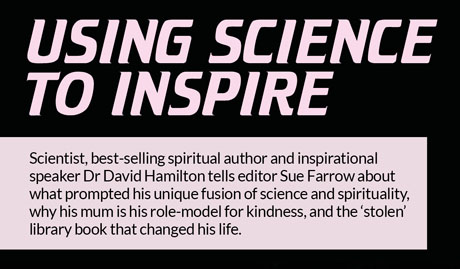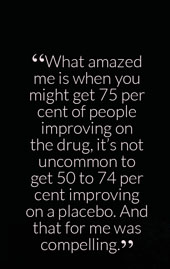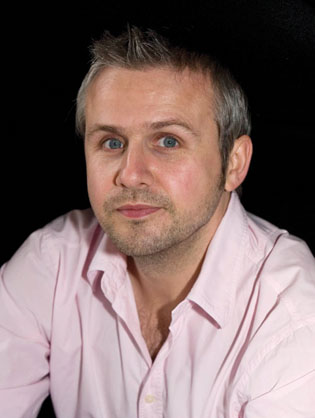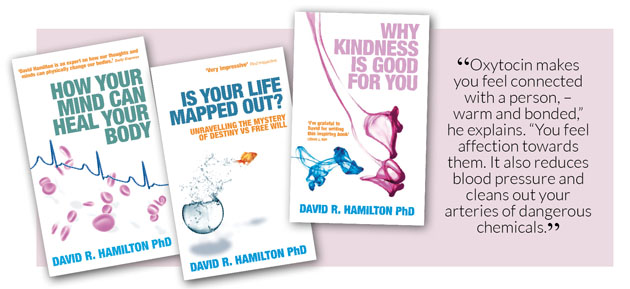

David Hamilton is a one-off.
He has a first class honours degree in chemistry and a PhD in organic chemistry. He worked for several years in the pharmaceutical industry, developing drugs for cardiovascular disease and cancer.
But here’s the one-off bit: he’s also a bestselling author for the world’s most respected spiritual and metaphysical publisher, Hay House, and an inspirational speaker in huge demand for talks and workshops that, in his own words, “use science to inspire”.
So how did this unique fusion of science and spirituality, subjects so often seen as polar opposites and mutually exclusive, come about?
“I worked for a big company called AstraZeneca, and basically my career was sticking atoms together to make molecules,” David explains. “But what interested me more than making the medicines was what happened when we tested them.
“You get a hundred patients with a drug and a hundred with a fake drug – a placebo. What amazed me is when you might get 75 per cent of people improving on the drug, it’s not uncommon to get 50 to 74 per cent improving on a placebo. And that for me was compelling.
“I was fascinated by this placebo effect, how people improve through believing they are receiving a drug. Working in drug development exposed me to that effect so I began to study mind-body interactions in my spare time.
“I was interested in the mind, metaphysics and all that kind of stuff before I even did my PhD, but I kind of shelved it when I put my brain into academic mode for a few years. But once I started seeing those placebo results, it reignited things I was really passionate about, so in my spare time I was researching mind over science.”
|
 |
| |
David Hamilton
|
So we could say that the placebo experience drew the two major aspects of David’s life together very neatly?
“It pretty much did. I think it was my catalyst. It’s ok reading stuff, but when you’re working with drugs and spending a quarter of a billion dollars and seven years of research to dilate a blood vessel, for example, then you find that someone believing they’re getting a drug and it’s made of sugar, gets the same result? So, quarter of a billion dollars or nothing other than a thought? Hmm. . . I wonder which you’d go for?”
Sounds like a no-brainer when you put it that way.
After four years David decided to leave the world of pharmaceuticals because he wanted “to write and speak about the mind and help people to believe in themselves more.”
He also wanted to write and speak about kindness and spread the idea that a small group of people with compassion and kindness in their hearts can change the world.
David’s book, Why Kindness is Good for You, published in 2010, has proved hugely successful. It made me wonder if the seeds of his passion for human kindness were planted long before his light-bulb moment over the placebo effect.
“My mum was my hero when I was growing up, and she still is. She was a model of kindness. She didn’t say things like ‘this is how you should behave’, but children learn just from being in the presence of people, copying their behaviour, learning right from wrong. My mum is naturally highly compassionate and kind. She’d gladly give you the shirt off her back if she knew you needed it, and I just grew up in that environment.
“I went to a Catholic school, but my mum and dad didn’t really encourage us to go to mass – it was very much my own choice,” he says. “But I developed an interest in spirituality, I suppose, because I was interested in the mind, something my mum, who was suffering with post-natal depression after the birth of my younger sister, kindled in me unintentionally.
“As daft as this might sound, I was about eleven years old and I was on a tour of the public library with my English teacher. Suddenly a book fell off the shelf. It was called The Magic Power of your Mind, and I took it. Well, I didn’t know you were supposed to hand in a library card!”
I laugh with delight at the thought of an international spiritual career being launched on the back of a nicked library book, and ask David if he ever returned it.
“No,” he answers unashamedly. “My mum still has it. It’s 32 years overdue!”
And does he see that falling book as one of those ‘meant-to-be’ kind of events?
“I do,” he says. “I absolutely believe it was meant to happen, because when I gave the book to my mum, she devoured it, even though she wasn’t really a person to be reading books. It didn’t cure her in a day, but it gave her a sense that our ways of thinking can change things.
“I would often hear her excitedly and passionately saying: ‘It’s all in the mind. It’s mind over matter. I can do it, and you can do it’. It was a drip-feed into my consciousness that the mind is more than just something you think with. It can really shape your health and your life.”

While emphasising that I don’t have a scientific bone in my body (I narrowly scraped a pass in biology O-Level) I hazard a guess that all sorts of chemical things happen in the body, depending on what we’re doing at the time. Tentatively I ask if the feel-good factor that sometimes washes over us when we’ve helped someone, might be down to some kind of chemical ‘afterglow’.
“Absolutely,” David concedes. “There’s an elevation of dopamine in the brain, in the little pleasure centres that make you feel good. There’s also a production of the brain’s natural versions of morphine and heroin.”
This leads us neatly to my next question – the role of the hormone oxytocin (otherwise known as the ‘bonding hormone’ or the ‘love hormone’), about which David has written extensively.
“Oxytocin makes you feel connected with a person – warm and bonded,” he explains. “You feel affection towards them. It also reduces blood pressure and cleans out your arteries of dangerous chemicals.”
It definitely sounds like the kind of chemical that should be bottled! Can its production be switched on automatically without a triggering mood change? How does it work?
“We produce oxytocin when we make a warm contact with someone,” he says. “If we hold someone’s hand affectionately, or show compassion. But you could produce it when you feel inspired. A woman who has a young baby only has to think of her baby and she’ll start to produce breast milk. The breast milk needs oxytocin for production, and the thought of the baby is enough.
“The human body is genetically wired to connect, to experience positive emotion when we connect with each other. It’s part of the legacy of evolution that’s caused the human species to thrive through millions of years.
“We are a social species, so when we connect with each other the human psyche naturally increases in positivity. We don’t even have to try, it’s natural.”
It’s clear there’s a whole hidden world of inter-connectedness between our spiritual and biological selves – a massive opportunity for ongoing research.
“Absolutely,” says David. “And I find that what science is really doing is providing credibility and support for a lot of the things that people with an interest in spirituality and the healing arts have been saying for hundreds and thousands of years. Science is kind of validating it – not that it needs to be validated – but that’s what it’s doing.”
Interestingly he adds that the birth of social media has provided an unexpected bonus for social scientists to study human connection in new and exciting ways they never have before.
”Social scientists and psychologists can use data to look at the health benefits of connectedness and it’s confirming what evolution projected, that we are at our healthiest and happiest when we’re connected, when we’re interacting warmly with people.”
Perhaps incongruously, the subject of near-death experiences comes to my mind. We read powerful testimony from people who have had an NDE and returned to life suffused with a longing to do good to their fellow man and woman. I ask if any research has been conducted into body chemistry prior to and after a NDE.
“No general investigation,” says David. “But you’ve probably heard of Anita Moorjani’s case. She wrote the book Dying to be me. I met her about eighteen months ago when we spoke at the same conference, and I was profoundly moved by her story. She had stage 4 cancer and no one has ever recovered from her type of cancer at that stage before.
“After her NDE it dissolved completely within one month. I think the analogy given was ‘like snowballs melting on a hot stove’. So, that kind of case is a demonstration of chemistry before and afterwards. It’s been corroborated by oncologists who were baffled by what had happened.
“Anita told me that the most profound thing impressed upon her as she was returning to her body, the single most important thing human beings have to learn, is how to love themselves. She knew by what was impressed upon her that the choice was to love herself without reservation, in other words be completely authentic, completely herself.
“Just be yourself and the right people will love the real you. Once in a physical body where the consciousness was loving itself completely, Anita knew that the cancer could not survive. It didn’t mean it was the same for every person with cancer, but in her particular case, what she knew 100 per cent was that in the chemistry of the body produced by a consciousness that loves itself entirely, cancer cannot survive, and that’s exactly what happened to her.”
Speaking of healing, I tell David that my assistant editor Paul Brett attended one of his seminars and has several times told me he was staggered by the power of the quantum field healing meditation led by David on that day.
“Basically, I created it because I was looking for a way of taking people out of the normal way of thinking about illness. When we’re thinking of an illness, we think of it physiologically, at the level of cells, maybe. But if we look at a diseased cell, we’ll find DNA; if we look into the DNA we’ll find atoms; if we look inside an atom there’s almost nothing there – it’s 99.9 per cent empty space.
“If a proton was the size of a tennis ball, the closest electron would be a grain of sand and it would be about 2km away! That’s the reality inside the atoms in your body. In quantum field healing I take people down through biology into the cells, into the DNA, into the atoms, to the particles, to the quantum field, and then instead of imaging and visualising and illness disappearing, because classically we do visualisation, where we imagine a tumour getting smaller and smaller and smaller – illness into wellness.
“So when they get to the quantum field, they do the same strategy of illness into wellness.They imagine the waves of illness, they just imagine intuitively what those waves of illness in the quantum field will be like, and we convert them into waves of wellness.
"Then we come back out of the body by the same route we took in; back out through the particles, the atoms, the DNA, the cells, back to the body.”
And what of the future for David? He’s now working hard on a new book about the science of self-love, for which he says Anita Moorjani was the inspiration.
“I’ve got to finish it by the summer, and it comes out next January. It’s going well at the moment. It feels like my strongest book so far, so I’m very excited about it.”

